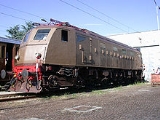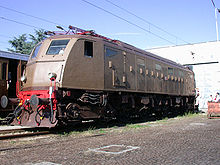
FS Class E428
Encyclopedia
The FS
E428 was a class of Italian railways electric locomotive
s. They were introduced in the course of the 1930s, for fast services on the Florence
-Rome
line, being decommissioned in the 1980s.
-Rome mainline at 3,000 V DC. This was also permitted by the introduction of new metallic passenger cars, capable of relative higher speeds. The requirement was shipped the to the FS design team of Ing. Giuseppe Bianchi
at Florence
.
The new locomotive was impressive for the times: huge, heavy, powerful and fast. They were 4 metres longer than the E626
, the first Italian DC electric locomotives, and weighed 10/20 tons more. The original requirement asked for the notable service speed of 150 km/h, but this was later reduced to 130 km/h.
The E428 was to be built in conjunction with a lighter version, the E326
, but those proved unsuccessful and were limited to lower speeds.
The first wheel arrangement devised was a 2-Do-2, with four trailing axles at the fronts and a single motor driving four central axles. However, the experiences with the E326 suggested to split the central bogie
into two motorized ones. The first locomotive, E428.001, was released in May 1934. A first series, for a total of 97 units, was produced until 1937. A second order in the same series requested a shorter gear ratio (29/103) and larger air intakes, which caused an increase in weight of four tons.
 The second series (81 units) differed in the removal of the frontal bonnets, replaced by a more profiled driving cabin: this set a style which was adopted for all the following Italian locomotives. A third order was issued on April 5, 1939 for 80 locomotives, but the construction was halted by the outbreak of World War II
The second series (81 units) differed in the removal of the frontal bonnets, replaced by a more profiled driving cabin: this set a style which was adopted for all the following Italian locomotives. A third order was issued on April 5, 1939 for 80 locomotives, but the construction was halted by the outbreak of World War II
after the completion of 39 units. Some of those locomotives, built by Ansaldo
, were theoretically capable of speeds up to 150 km/h.
All the E428s, aside from two, were repaired or rebuilt after World War II. Curiously, the bronze fascist lictor
ial crests on the front were removed only in 1946. In the 1960s the "Fast sub-class", with the 34/98 gear ratio, was built back to the shorter 29/103.
Ferrovie dello Stato
Ferrovie dello Stato is a government-owned holding which manage infrastructure and service on the Italian rail network. The subsidiary Trenitalia is the main rail operator in Italy.-Organization:Ferrovie dello Stato subsidiaries are:...
E428 was a class of Italian railways electric locomotive
Electric locomotive
An electric locomotive is a locomotive powered by electricity from overhead lines, a third rail or an on-board energy storage device...
s. They were introduced in the course of the 1930s, for fast services on the Florence
Florence
Florence is the capital city of the Italian region of Tuscany and of the province of Florence. It is the most populous city in Tuscany, with approximately 370,000 inhabitants, expanding to over 1.5 million in the metropolitan area....
-Rome
Rome
Rome is the capital of Italy and the country's largest and most populated city and comune, with over 2.7 million residents in . The city is located in the central-western portion of the Italian Peninsula, on the Tiber River within the Lazio region of Italy.Rome's history spans two and a half...
line, being decommissioned in the 1980s.
History
When in the 1930s, in the course of the Fascist government's program of railways development, a new locomotive was needed to provide a fast service on the newly-electrified MilanMilan
Milan is the second-largest city in Italy and the capital city of the region of Lombardy and of the province of Milan. The city proper has a population of about 1.3 million, while its urban area, roughly coinciding with its administrative province and the bordering Province of Monza and Brianza ,...
-Rome mainline at 3,000 V DC. This was also permitted by the introduction of new metallic passenger cars, capable of relative higher speeds. The requirement was shipped the to the FS design team of Ing. Giuseppe Bianchi
Giuseppe Bianchi (engineer)
Giuseppe Bianchi was an Italian railway engineer on the Ferrovie dello Stato between 1913 and 1946.-Life:Born at Imola, Bianchi graduated in electrical mechanical engineering at the University of Turin in 1912...
at Florence
Florence
Florence is the capital city of the Italian region of Tuscany and of the province of Florence. It is the most populous city in Tuscany, with approximately 370,000 inhabitants, expanding to over 1.5 million in the metropolitan area....
.
The new locomotive was impressive for the times: huge, heavy, powerful and fast. They were 4 metres longer than the E626
FS Class E626
The FS E.625 and E.626 are two classes of Italian electric locomotives produced for the Ferrovie dello Stato. They were introduced in the course of the 1920s and remained in service until the 1990s...
, the first Italian DC electric locomotives, and weighed 10/20 tons more. The original requirement asked for the notable service speed of 150 km/h, but this was later reduced to 130 km/h.
The E428 was to be built in conjunction with a lighter version, the E326
FS Class E326
The FS E326 was a class of Italian railways electric locomotives. Designed in 1929, they were introduced in the early 1930s, for hauling passenger trains at relatively high speed.-History:...
, but those proved unsuccessful and were limited to lower speeds.
The first wheel arrangement devised was a 2-Do-2, with four trailing axles at the fronts and a single motor driving four central axles. However, the experiences with the E326 suggested to split the central bogie
Bogie
A bogie is a wheeled wagon or trolley. In mechanics terms, a bogie is a chassis or framework carrying wheels, attached to a vehicle. It can be fixed in place, as on a cargo truck, mounted on a swivel, as on a railway carriage/car or locomotive, or sprung as in the suspension of a caterpillar...
into two motorized ones. The first locomotive, E428.001, was released in May 1934. A first series, for a total of 97 units, was produced until 1937. A second order in the same series requested a shorter gear ratio (29/103) and larger air intakes, which caused an increase in weight of four tons.

World War II
World War II, or the Second World War , was a global conflict lasting from 1939 to 1945, involving most of the world's nations—including all of the great powers—eventually forming two opposing military alliances: the Allies and the Axis...
after the completion of 39 units. Some of those locomotives, built by Ansaldo
Gio. Ansaldo & C.
Ansaldo was one of Italy's oldest and most important engineering companies, existing for 140 years from 1853 to 1993.-From foundation to World War I:...
, were theoretically capable of speeds up to 150 km/h.
All the E428s, aside from two, were repaired or rebuilt after World War II. Curiously, the bronze fascist lictor
Lictor
The lictor was a member of a special class of Roman civil servant, with special tasks of attending and guarding magistrates of the Roman Republic and Empire who held imperium, the right and power to command; essentially, a bodyguard...
ial crests on the front were removed only in 1946. In the 1960s the "Fast sub-class", with the 34/98 gear ratio, was built back to the shorter 29/103.

